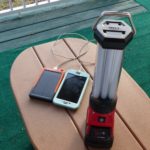by Marion Patterson | Mar 23, 2023 | (Sub)Urban Homesteading, Energy Efficiency, Home Improvements
Are battery-powered chainsaws worth the money?
We decided to find out. *
Gas chainsaws have been around for decades. Rich wondered if newer electric battery-powered chainsaws would be as functional and easier to use. So, he acquired a Milwaukee saw with a 16-inch bar and put it to the test alongside his trusty Stihl gas model.
Back in the mid-1970s Rich worked in Idaho felling Douglas Fir and Ponderosa Pine trees. He used a heavy noisy gas fueled chainsaw that was amazingly powerful as it chewed through thick trunks. Years later he bought a Stihl gas-powered saw used to cut the four or five cords of wood we burn each winter for heat. It’s a well-built powerful saw.
A few days after the new battery saw arrived, we heard a crack/boom as a huge oak crashed down across one of our backyard trails. Rich guided the new saw as it sliced through the log, and emerged smiling. “It’s amazing,” he said.
After further use he developed this chart of the pros and cons of the battery vs the gas saw:
Gas: Pro – Plenty of Power, No need to recharge batteries, Longer bar
Gas: Con Noisy and heavy, Must mix/carry/store gas, Must replace gas & air filters, Engine stalls, Pull cord start hard on the shoulder.
Battery: Pro – Plenty of Power, Relatively quiet, Less maintenance, Fairly lightweight, Trigger start, No need to idle, Easy start
Battery: Con – Need a nearby electric outlet to recharge the battery, Shorter bar than a gas saw
Bottom Line. Which One to Buy
Rich has both a gas and electric battery saw. Both are well-made by reliable companies. So, if he didn’t own a saw and needed to cut up trees fallen in the yard which type would he buy?
“I’d buy a quality battery saw. They are easy to use, cut fast, and there’s no need to buy, mix, and store gas. They are also quiet, but I still use hearing protection when using one. There are major advantages of battery over gas. One is
eliminating the need to pull a cord to start it. You just pull the trigger. The second is especially helpful when cutting a fallen tree with branches. Often this requires cutting, then putting the saw aside to clear away the cut branches, then using the saw to cut more. Gas saws don’t idle well and often stall, requiring another pull on the starter cord. Also, when idling gas saws burn fuel and spew emissions. Battery saws excel when there’s a need to cut and then move wood.”
Battery-powered chainsaws use lots of electricity. He was able to cut 13 15-inch diameter black oak logs on one charge with a 12-amp hour battery. The saw will function well on batteries with lower amp hour ratings, but they will run down sooner. He suggests having two 12-amp hour batteries and notes that being close to a power source for recharging is useful. It is likely that the cost of recharging a battery is lower than the comparable amount of energy in gasoline but it’s difficult to make a comparison.
Safety
Operating any chainsaw must be done with safety in mind. Here is Rich’s list of safety precautions to keep in mind:
- Get saw training. In-person training is best but YouTube videos help.
- Always wear protective equipment that includes saw chaps, leather gloves, hearing, ear, head and eye protection, and sturdy leather boots.
- Saw with a partner nearby and carry a cell phone in case of emergency.
- Keep the chain sharp. YouTube videos show how to sharpen.
- Rest before you get tired.
- Be alert. Save the cold beer for after you are done.
-
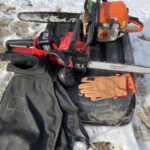
-
Gas and battery saws with protective equipment.
-

-
Rich in protective equipment.
-
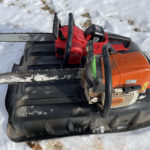
-
Quality gas and electric saws.
Final Thoughts
Rich has years of experience using many power tools and shares these thoughts:
Quality pays. “I buy quality tools, even if I have to wait until I save up enough money. Most of my tools are Milwaukee brand. The same batteries that power my chainsaw also power my drills, fans, vacuum cleaner, lights, inflater, hedge trimmer and other saw types. Many quality brands are on the market. They have their own specific type of battery that won’t work with other brands. So, I consistently buy the same brand for convenience.
Yard Tool’s Future
At Winding Pathways, we have replaced our gas lawn mower, snowblower, and now chainsaw with battery-powered equivalents. They are excellent and come with benefits over gas models. We see gas yard tools moving toward obsolescence and battery-powered ones becoming ever more versatile.
Disclosure*
Rich has purchased, at retail cost, most of his power tools. Milwaukee has provided others for testing.
by Winding Pathways | Jan 19, 2023 | (Sub)Urban Homesteading, Energy Efficiency, Home Improvements, Preparedness
Power outages. They happen in an instant. Most are only a flicker but some can last for hours when the wind’s whistling and the temperature’s dropping outside. Or in summer when the heat rises.
What’s the best thing to do in power outages? Well, it’s best to anticipate it and be ready by having a few things ready to pull out of the closet when the lights go out. Here’s a short list:
Cooking and Food:
- Propane or gas camping stove with plenty of fuel stored away from the main residence. (i.e. in a stand-alone garage) If you live in an apartment or condominium have less volatile fuel options ready.
- A few days of nonperishable or dehydrated camping food.
- Several gallons of water stored where it won’t freeze.
Power Outages and Light & Heat:
Electronics:
- Cell phones and other electronic batteries drain quickly. A backup power source and solar-powered phone charger keep the phone working.
One More Important Item:
- In a widespread power failure credit and debit cards don’t work. Cash always does. Keep some cash in small bills to use during emergencies.
Many other items readily available in case of emergencies help keep life comfortable. Read about them on our other blogs. The list above covers only the most basic and sometimes overlooked, emergency items to keep on hand. Get ready now for power outages.
-

-
We found the meals tasty and filling.
-

-
emergency food
-

-
This two-burner Sterno keeps food warm but is less useful for cooking. Great for old style fondue parties!
by Winding Pathways | Jun 23, 2022 | (Sub)Urban Homesteading, Energy Efficiency, Home Improvements
Want to buy gas for a buck a gallon? Well, you can but you won’t find it at a service station. It’s available at the electrical outlet in the garage or shop.
Battery-Operated Tools
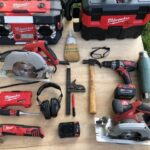
We switched to cordless tools gradually.
Nearly ten years ago we switched from plug-in carpentry tools to battery (cordless) equivalents. We loved them for their power, effectiveness, quietness, and ease of use. So, when battery-powered yard tools came on the market we gradually switched.
In 2018 we ditched our gas lawn mower and replaced it with a battery unit….with concern. Would it have the power of our gas machine to chew through tall grass and weeds? Would it have enough battery storage to mow the entire lawn?
Mowers

Maintaining the labyrinth is work. And a way to connect.
We quickly learned our concerns were false. The mower chewed through tough prairie grass and buzzed off our traditional lawn with ease. We liked it so much we bought another one so we could both mow simultaneously. Then came a trimmer, chain saw, and snow blower that all run on the same battery system. We love them all and believe gas-powered equivalents are on the road to obsolescence.
How about operating costs? Experts at our utility, Alliant Energy, told us that one gallon of gasoline has the energy equivalent of 33.7-kilowatt hours of electricity. As of mid-June 2022, gasoline average cost pushed to $4.60+ a gallon in Cedar Rapids. 33.7 kWh of electricity costs, on average in Iowa, $1.03.
Operating our battery tools costs a quarter of our old gas equivalents.
Benefits of Electric Tools
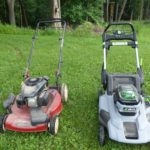
Comparison of a gas mower and the EGO cordless lawnmower.
But, there’s more than cost savings with battery-operated tools. Here are aspects we love about our mowers, trimmers, saws, and snowblowers:
- No rope to pull to start the machine. We save the shoulders! Just press a switch.
- No filters or oil to change.
- No need to buy and store gasoline. Fuel is always at hand at the electrical outlet.
- No fumes to breathe while operating.
- No noisy internal gas explosions. Battery electric machines are quiet.
- Easy to fold and store.
So, what are the downsides of battery-operated tools? We had to think about that and came up with only one thing. They may cost more than gas machines, and batteries are expensive. However, the batteries last a long time, perhaps as many as 2000 charge/discharge cycles.
The cost of electricity varies from place to place. Utilities print the kilowatt-hour charge on monthly bills. To calculate the cost of 33.7 kWh of electricity multiply that number by your per kWh cost and add in any taxes or service fees. Almost certainly it will cost less to charge a battery than to buy gas.
Have a cranky old gas mower? We suggest replacing it with a battery-powered equivalent.
by Winding Pathways | Mar 24, 2022 | (Sub)Urban Homesteading, Energy Efficiency
Many people dread the arrival of the monthly electric bill. We look forward to receiving it.
A few years ago, we hired Site Gen Solar to install an Enphase solar electric, or photovoltaic (PV), system on our barn roof. Although it’s a small system, when combined with our energy efficiency, monthly bills from Alliant Energy are tiny.
Our PV system does more for us than make electricity. It’s an instant weather scanner. We can access our Enphase app from anywhere and it tells us how much energy our system is producing in kilowatt-hours. One kilowatt-hour is enough energy to power a 100-watt light bulb for 10 hours. Our bulbs are LED and on average consume 12 watts.
On clear days our small system produces about 12-kilowatt hours. It powers our refrigerator, furnace fan, computers, and lights. When it produces more than we use, the excess goes out to the grid, subtracting cost from our bill.
The app tells us more. See these photos. When snow covers some panels, we can tell from the app that they weren’t producing much. When all panels are producing poorly, we know it’s a cloudy day or snow is covering all panels. Sometimes when we are traveling we open the app and learn about Cedar Rapids’ weather.
-

-
The Enphase app shows which panels are covered with snow.
-

-
Production drops when panels are covered with snow or clouds cover the sun.
by Winding Pathways | Mar 10, 2022 | (Sub)Urban Homesteading, Energy Efficiency
Only a few years ago few people had heard of lithium. Now almost everyone relies on this odd metal in their phone, laptop, and tools. It’s a world-changing element.
Metal????? Lithium is a truly odd metal. Iron, lead, and other common metals are heavy. Not lithium. It’s near the upper left corner of the periodic chart near hydrogen, the lightest element. Lithium is light, volatile, and scarce. Argentina and Chile, Australia, and China form the “lithium triangle” and hold the world’s greatest reserves. Smaller amounts are mined in the United States and other countries.
Many Uses
Lithium can jump. At least lithium-ion batteries can make a car jump. We experienced it when we drove a Chevy Bolt from Cedar Rapids to Dubuque. It’s an amazing car powered by energy stored in a lithium-ion battery, rather than gas. While driving on four-lane US 151 we stepped on the “gas” pedal and the Bolt jumped forward, swooping us around a sluggish car.
Lithium can also calm people down. For years it’s been an ingredient in drugs used to treat depression and bipolar disorder. The metal that makes a car jump can calm a person.
It’s also added to grease to make it even slicker.
Lithium Batteries
Lithium-ion batteries store plenty of energy, recharge quickly, and are making a huge change in American life. It started in 1991 when Sony used the first lithium-ion battery in camcorders. Since then, phones, tools, electronics, and even cars and trucks are powered by energy stored in these batteries.
We went “lithium-ion” a while back when we purchased Milwaukee Tool brand circular saws and drills. We were needlessly worried they wouldn’t be powerful and would run out of charge quickly. They were false fears. We love our battery tools and now have Milwaukee inflators, (i.e., to pump up tires), fans, and a pole saw. We also have EGO brand battery power lawn mowers, a trimmer, and a snowblower. They’re easy to use, quiet, and powerful. We love our battery-powered tools and can see a battery-energized car in our future.
-

-
The battery gives a powerful charge.
-

-
Batteries for the EGO snow blower are easy to charge.
-
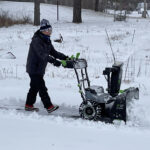
-
The EGO snow blower chews through heavy and light snow.
Pros and Cons
There are environmental and health benefits when using battery, or cordless, tools. They are quiet and don’t emit fumes. No need to pull a starter rope on the mower or blower anymore. Just flip a switch and vrrrooom! they go. Recharging batteries costs less than buying a comparable energy equivalent of gas, and there’s no flammable gas to lug home and store. It’s all good. There are downsides to lithium mining but the environmental positives outweigh them. Mining can be done responsibly.
Care of Lithium Batteries
Lithium-ion batteries are expensive but last a long time if given good care. Gerry Barnaby of EGO gave us these tips for battery care:
- Take the battery off the tool when it’s not in use.
- Protect batteries from extreme heat and cold. It’s a good idea to store them inside. EGO batteries are designed to discharge to 30% if not used for a few months at a stretch. It’s called “auto discharge” and light may flash, but this is normal. Just recharge the battery before using it.
- EGO batteries are designed to last for 1000 charges. To calculate the battery life divide 1000 by the times it’s used per year. So, if a battery is used 30 times a year it conceivably could last 33 years. But if you don’t believe it, cut those 33 years in half and cut it in half again and the end result is an eight-year life.
- When a battery is nearing the end of its life the run time will lessen. Then read a label on the side of the battery that gives a phone number. Call to learn where it can be recycled.
We’ll continue to invest in our battery-energized tools that are so easy to use.
by Winding Pathways | Jan 20, 2022 | (Sub)Urban Homesteading, Energy Efficiency, Garden/Yard
Back in October, we took a gamble. We bought an electric snowblower. Our driveway at Winding Pathways is about 440 feet long, and Iowa gets plenty of snow. It’s too much to shovel, so years ago we bought a gas snow blower. It worked for the first winter but then it started throwing belts off the drive wheels. Fixing was tedious and tenuous. So, we sold the beast and bought an EGO battery-powered two-stage snowblower.
We hoped it was a good decision. Would the blower be up to clearing such a long driveway? Would it hold up to hard use?
A heavy wet snowfall on December 28, 2021, gave us a chance to test the new machine. It did just fine. After clearing the entire driveway, the batteries still had charge to them. We could have done more.
It’s our prediction that gasoline-powered lawnmowers, hedge trimmers, blowers, chainsaws, and snow blowers are becoming obsolete. They’ve already been banned in California because they pollute the air more than cars.
Here are aspects of battery tools we like:
- They run quietly and are lightweight.
- No need to risk shoulder injury by pulling a rope to start it up. Just push a switch.
- No need to store gasoline.
- Maintenance is easy. No filters or spark plug to change.
- No fumes.
- Inexpensive to run. It costs less to recharge the battery than to buy an energy equivalent amount of gas.
It looks like our decision will pay off. We’ve now replaced all our gas-burning outdoor equipment with battery equivalents……except for one chainsaw. That may go soon.
Note: Winding Pathways paid the full retail price for this machine.

The EGO snowblower cut through the heavy snow easily.




